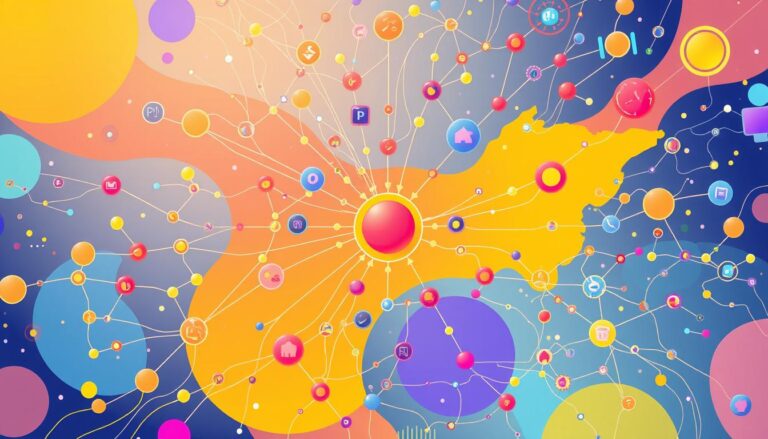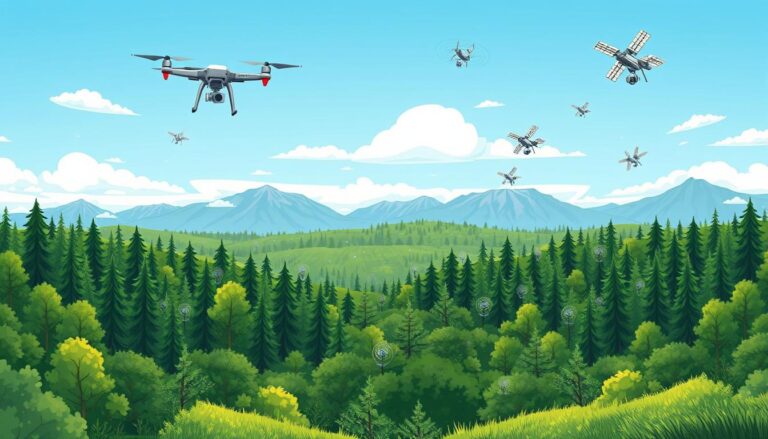Machine Learning in Crop Optimization
In the world of agriculture, machine learning is changing how farmers optimize crops. It uses data and algorithms to improve farming. Techniques like neural networks help analyze weather, soil, and past data for better decisions.
Data is key in agriculture. Machine learning uses it to help farmers. For example, it predicts weather and soil conditions to guide decisions.
Machine learning helps farmers everywhere. It’s used in Argentina, Europe, and India to improve farming. It also helps with crop quality and disease detection.
Machine learning is vital for a changing world. It helps farmers grow more food with less waste. It’s part of a future where farming is more efficient and sustainable.
Key Takeaways
- Machine learning is transforming traditional farming into precision agriculture, optimizing crop yields and resource management.
- LSTM RNN and Random Forest Classifiers demonstrate high accuracy in weather prediction and crop selection, respectively.
- Machine learning applications in crop optimization span various regions and specialized areas, such as crop quality, weed identification, and disease detection.
- The integration of machine learning with IoT devices, big data analytics, and precision agriculture techniques is crucial for sustainable farming practices.
- Machine learning holds the key to addressing the challenges of climate change and food security in the future of agriculture.
Understanding the Basics of Machine Learning in Agriculture
Machine learning has changed the game in agriculture. MIT Computer Science Professor Aleksander Madry says, “Machine learning is changing, or will change, every industry. Leaders need to understand the basic principles, the potential, and the limitations.” By using data-driven farming, farmers can improve their operations and make better decisions. This leads to higher crop yields and better efficiency.
What is Machine Learning?
Machine learning is a part of artificial intelligence. It lets computers learn from data without being programmed. It uses algorithms to find patterns and make predictions from the data. These algorithms are either supervised or unsupervised, depending on the data used.
The Importance of Data in Agriculture
Data is key to machine learning in agriculture. Smart farming technologies like sensors and drones help collect lots of data. This data includes soil moisture, weather, and crop health. It’s used to train models that offer insights and predictions for better crop management.
“Researchers have found that accurate yield prediction in agriculture is a complex process. It considers environmental factors, management practices, genotypes, and phenotypes to affect yield.”
How Machine Learning Works in Crop Optimization
Machine learning helps in many ways, like predicting yields and detecting diseases. For example, crop growth modeling uses data to forecast future yields. By analyzing weather, soil, and crop history, farmers can plan better.
Machine learning also helps spot diseases early. This lets farmers act fast to save their crops. Companies like Aibono and VineView use it for disease detection and quality checks. This is changing how farmers manage their crops.
Benefits of Machine Learning for Farmers
Machine learning has changed farming, giving farmers tools to improve their work. It uses data and algorithms to help farmers make better choices. This leads to more crops, better use of resources, and higher profits.
Increased Crop Yields
Machine learning helps farmers grow more crops. It looks at soil, weather, and plant health to suggest the best times to plant. This way, farmers can grow more with less waste.
Studies show machine learning helps farmers use water and fertilizer wisely. This means more crops with less effort and cost.
Efficient Resource Management
Machine learning is key in using resources well in farming. Water is a big deal, with 70% used for farming. Machine learning helps farmers water just when and where needed.
This cuts down water use without harming crops. It also helps farmers choose the right plants for their soil. This means more crops with less effort.
Predictive Analytics for Better Decision Making
Predictive analytics change how farmers decide. Machine learning looks at past and current data to forecast crop yields. This helps farmers plan and make smart choices about planting and harvesting.
It also spots diseases early, saving crops and animals. Farmers can keep their plants and animals healthy. This leads to more and better crops.
Machine learning helps farming be more sustainable. It cuts down on chemicals and uses resources better. As the world’s population grows, farming tech like machine learning will be key. It will help feed more people without harming the planet.
Machine Learning Techniques Used in Crop Optimization
In agricultural AI, many machine learning methods help improve crop growth and yield. These advanced algorithms look at lots of data from remote sensing in agriculture, weather, soil, and past crop results. They give farmers and agronomists important insights.
Machine learning models for crop growth modeling can forecast yields and suggest the best crops for areas. They also help manage resources well. This way, farmers can make better choices, cut down waste, and farm more sustainably.
Neural Networks
Artificial neural networks (ANNs) are often used for crop optimization. They work like the human brain, learning from big datasets and making good predictions. Recurrent neural networks (RNNs), a special type of ANN, do well in predicting weather and picking crops.
In Karnataka, India, a study used data from 1998 to 2018 to train neural networks for crop yield prediction. The data covered 43 crops across different seasons. The networks found areas with high yield potential by looking at yield, area, and production.
Decision Trees
Decision trees are also great for crop optimization. They create a model of decisions and outcomes, helping farmers choose wisely. Random forest classifiers, a group of decision trees, are good at picking crops and predicting yields.
In precision agriculture, decision trees analyze data from satellites, drones, and sensors. They check crop health, soil, and weather. With historical data, they suggest the best planting times, fertilizers, and irrigation.
Genetic Algorithms
Genetic algorithms, based on natural selection and evolution, optimize crop management. They simulate genetic changes to find the best solutions for complex problems. This includes finding the best crop rotation patterns and selecting the right crop varieties for the environment.
A vineyard using AI, including genetic algorithms, cut water use by 30%, reduced chemicals, and improved grape quality. This was thanks to drone and AI data analysis.
The table below shows how machine learning can impact crop optimization:
| Machine Learning Technique | Potential Impact |
|---|---|
| Neural Networks | Accurate yield prediction and crop selection |
| Decision Trees | Optimized resource management and precision agriculture |
| Genetic Algorithms | Improved crop rotation patterns and variety selection |
Real-World Applications of Machine Learning in Crop Optimization
Machine learning has changed farming, helping farmers grow more crops and get better yields. It uses data to guide farmers, making their work more efficient. Let’s look at how machine learning helps in farming.
Precision Agriculture
Precision agriculture uses machine learning to manage water, fertilizers, and pesticides. It looks at data from sensors and satellites. This way, it gives farmers exact advice on how to care for their crops.
This approach boosts crop yields and supports green farming. The market for precision agriculture is growing fast, expected to hit $12.9 billion by 2027. This shows how important smart farming is becoming.
Pest and Disease Detection
Diseases and pests can hurt crops a lot. Machine learning can spot these problems early. It looks at photos from drones or phones to find issues.
In India, a machine learning app helps farmers by identifying diseases. This crop disease detection tech helps farmers save their crops and keep them healthy.
Yield Forecasting
Knowing how much to harvest is key for farmers. Machine learning can guess yields based on weather, soil, and past data. This helps farmers plan better and make more money.
At the University of California, Davis, machine learning boosted grape yields by 20%. It also cut water use by adjusting irrigation and fertilizers.
| Application | Benefits |
|---|---|
| Precision Agriculture | Optimized inputs, increased yields, sustainable practices |
| Pest and Disease Detection | Early detection, timely action, minimized crop losses |
| Yield Forecasting | Accurate predictions, optimized resource allocation, increased profitability |
Machine learning has huge potential in farming. AI in agriculture is set to grow from $1.7 billion in 2023 to $4.7 billion by 2028. As more farmers use data-driven farming, farming will change a lot. It will become more productive, sustainable, and profitable.
Future Trends in Machine Learning and Agriculture
Technology is advancing fast, and machine learning in agriculture is getting exciting. ML algorithms are being used with IoT devices like sensors and drones. These devices collect and analyze data in real-time, giving farmers insights for better decisions.
By using big data, ML models can learn and make predictions. This helps farmers manage crops more effectively. It’s a big step towards better farming.
Machine learning is also helping with sustainable farming. It looks at weather, soil, and crop growth data. This helps farmers use resources better and reduce environmental harm.
For example, ML can help use less water and fertilizer while keeping yields high. It can also spot pests and diseases early, cutting down on harmful chemicals.
Integration with IoT Devices
Machine learning and IoT devices are changing farming. Sensors in fields collect data on soil and weather. Drones take pictures of crops from above.
This data goes into ML algorithms for real-time analysis. For instance, ML might spot water stress in crops and suggest irrigation changes. This helps farmers make better decisions and grow crops more efficiently.
Sustainable Farming Practices
Machine learning supports sustainable farming too. It looks at weather, soil, and crop data to suggest better practices. For example, it might suggest using cover crops to improve soil.
It can also tell farmers the best times to plant and harvest. This way, farmers can be productive while being kind to the environment.
The Role of Big Data in Agriculture
Big data is key for machine learning in farming. IoT devices and advanced imaging give farmers lots of data. But, this data needs to be analyzed.
Machine learning does this by finding patterns in large datasets. For example, it can predict crop yields from satellite images and weather data. This helps farmers make smart decisions.
As data collection and processing get better, machine learning in agriculture will grow. It’s an exciting time for farming.
Source Links
- Machine learning-based optimal crop selection system in smart agriculture – Scientific Reports
- Frontiers | Harnessing the power of machine learning for crop improvement and sustainable production
- What is Machine Learning & How Will it Benefit Agriculture?
- Machine Learning in Agriculture: Top Applications – InData Labs
- Machine Learning in Agriculture: A Comprehensive Updated Review
- Machine Learning in Agriculture – EffectiveSoft
- How AI and Machine Learning are Revolutionizing Agriculture
- Optimization of Crop Recommendations Using Novel Machine Learning Techniques
- AI in Agriculture: Optimizing Crop Yield and Resource Management
- Applications of Machine Learning For Precision Agriculture
- Machine Learning in Agriculture: The Future-proof Use Cases
- Machine Learning Applications in Agriculture: Current Trends, Challenges, and Future Perspectives
- Recent Trends and Future Research Avenues
- Maximizing Farm Yield in 2024: AI in Agriculture ERP Systems







